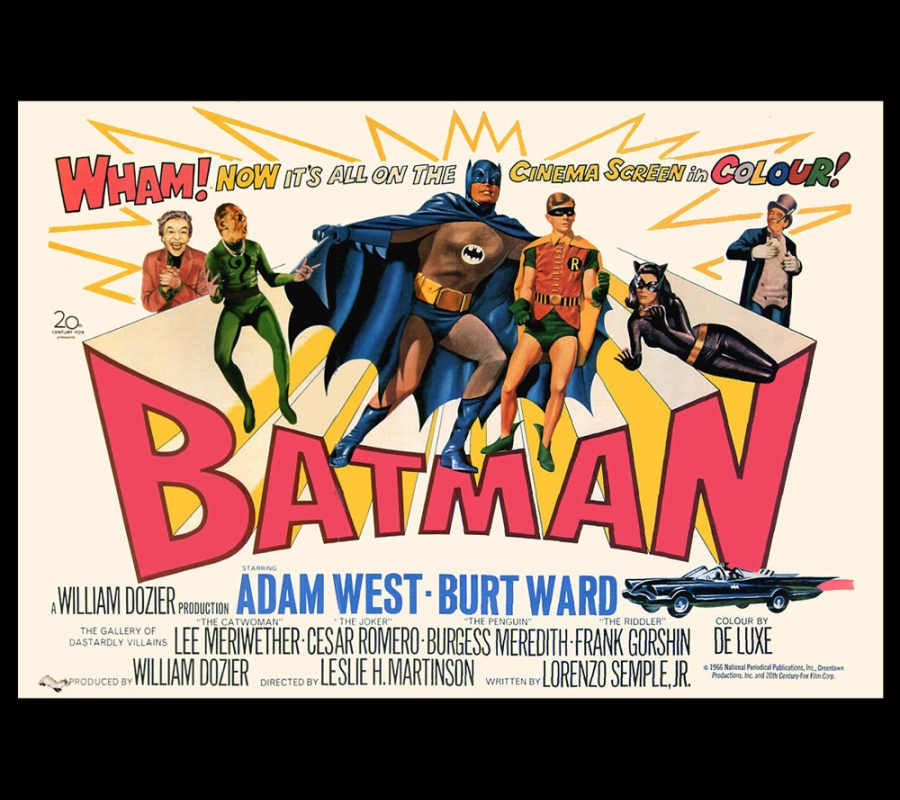If the later Batman films of the early 1990s, and then again in the late 2000’s, did anything at all, it was that they were made competently and intelligently enough to render a scene in which two fully grown adults decked out in funny costumes and/or rubber could share the screen and not have the whole thing come across as complete farce. When, in Nolan’s The Dark Knight, an interrogation-set scene between the oft-eponymous hero of the series, Batman, unfolds with him sitting opposite a man decked out in an odd, purple waistcoat whilst caked in makeup, our attention is drawn away from the silliness of the premise of such a sequence and to what it is they’re saying and to how it is this affects the overall picture. Leslie Martinson’s 1966 incarnation of Batman is a fair stretch back from these rather heady echelons, an awkward film; a film so unsure of itself that it effectively apologies during the opening credits for its blandness. If Burton and Nolan were able to, at the best of times, take this idea of a man determined to fight crime in a rubber body suit and mutate it into a series of semi-serious quests, then ’66 Batman rubs it the other way and turns it into pure panto.
Adam West reprises his role as Batman from the popular TV show of around the same era, the crime fighting alter-ego of Bruce Wayne; a reclusive millionaire whose funds and general set up allow him to live that masked double life. With him is his faithful sidekick Robin, played by Burt Ward as well as long-time butler Alfred (Napier), the third and only other individual aware of the heroes’ true identities. The duo live a life constantly on the lookout for the ‘call’ and they stand for all things just and righteous; their actions promoting ethical behaviour, the controlling of one’s alcoholic consumption and then later on, in a rather painfully obvious fashion, they will verbally reiterate the importance of equality. When, early on at a press conference, a journalist asks them to reveal their faces, everyone in the room is upset, but Batman is not and deals with the situation calmly and sensibility instilling further attributes of such a nature. When the leads journey to crime scenes via air or what-have-you, police officers will salute them as they pass; women in bikinis will come over all-flustered and the general public will look on with confidence.
Things kick off with a situation involving a luxury yacht out at sea, a situation that goes badly highlighting that Batman and Robin are not completely infallible. The boat’s crew get away from the heroes, and fall into the hands of the film’s villains. The opening escapade does not go badly enough to terminate the duo and thus the villains, in their lair shot via canted angles in contrast to how normally prior scenes involving law-abiding officials were shot, hatch a fresh plan to kill them off once and for all. From an antagonistic perspective, this is The Penguin’s (Meredith) film; the other three, bar Meriwether’s Catwoman (but only on occasion) are superfluous. One instance seeing Frank Gorshin’s Riddler react with clear glee as he moves to undertake yet another attempt to kill Batman, stating that he needs Batman to exist so that he may try to kill him, which he deduces is in turn the reason he even exists. Such a mangled logic does not work in a film as underplayed in the theoretical and philosophical department as ’66 Batman is – again, later ideas of this ilk of both men needing one another to co-exist at once were explored in Nolan’s The Dark Knight.
On a similar tract, the employing of an out of costume Catwoman (under the guise of Kitka, a Russian journalist) to get to know Wayne mirrors that of what Burton would later explore in “Returns”; specifically, when said film’s characters of Selina Kyle and Wayne would come together away from trying to hurt one another whilst in costume. As they bonded, Burton unfolded a change in Kyle’s man-hating beliefs – thinking’s that were challenged by Wayne’s naturality as a male. That film’s tragic finale, in which she chose to pursue her ill-thought deductions over that of a happier and more moral ending with Wayne, saw her finally getting around to murdering the man whom was responsible for her entering of this present incarnation and though-process, and the whole sub-plot had the sort of heart that is sorely lacking here.
If anything, the film is too long and too chock full of villains for it too really work; we’ve all seen an episode of the old 1960s television series, and they were good fun when one was young enough to enjoy them to the proper capacity. They were short and sharp, barely thirty minutes in length and saw one baddie, or pack of baddies, at a time try to thwart our Batman and Robin. Here, what is essentially the same idea, or approach to the material, is stretched out into a length of over an hour and a half – consequently, it is unable to support what Martinson and co. are doing. The film is cluttered; confused; often dull; with too many villains and just rather bad – like a joke that wears out its welcome, ’66 Batman has fun with its skirmishes against bad guys guilt-edged pleasures but by the hour mark is all too much to handle.

